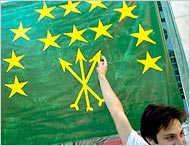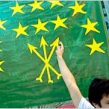
Support for Circassian Nationalism Grows in the North Caucasus
Publication: Eurasia Daily Monitor Volume: 6 Issue: 222
By:

Rising tensions in Kabardino-Balkaria (KBR) involving two neighbouring republics Karachaevo-Cherkessia (KChR) and Adygeya (EDM, November 25) have led to violence. On December 1, the headquarters of the “Khasa” Circassian in Nalchik was attacked by a group of 50 people described as well-built sportsmen. The attack happened the day after the “Khasa” released a declaration of its goal to unite the Circassian republics and create an independent state (www.lenta.ru, December 1).
The young leader of the Circassian Congress of the KBR, the scholar and political activist Ruslan Keshev, who is known for his public resistance against the Sochi Olympics and his aspiration for recognition of the Circassian “genocide,” was hospitalized with multiple injuries after being brutally beaten. In the statement released immediately after the December 1 attack, “Khasa” gave details of the incident. According to the statement, the attackers’ goal was to neutralize physically the Circassian leaders in order to prevent them from holding a national meeting set to take place in Nalchik on December 5 (www.elot.ru, December 1).
On November 26, four days prior to the attack on the Circassian leader in Nalchik, a national protest demonstration took place in the neighbouring republic of Karachaevo-Cherkessia. More than 3,000 young Circassian and Abaza people (ethnic cousins of the Abkhaz) attended the demonstration, which took place in Cherkessk, the KChR capital. Approximately 200 Circassians from Kabardino-Balkaria, led by Ibragim Yaganov and Ruslan Keshev, drove from Nalchik to participate in the protest. The group was blocked at a checkpoint by the Stavropol Krai police. The Circassian delegates were told to leave their vehicles and walk to Cherkessk if they really intended to join the demonstration. Given that the distance from the checkpoint to Cherkessk is more than 35 miles, the suggestion to walk made by the police was not a serious one. However, the Circassians left their cars at the checkpoint and marched four miles on the highway holding Circassian flags until forty vehicles sent from Cherkessk arrived to pick them up (https://www.youtube.com/watch?v=WlIN83Vn1EA).
The demonstration in Cherkessk declared a need for an emergency national meeting to discuss and decide on immediate steps the Circassians need to take in order to survive in the Motherland. On November 28, two days prior to the attack on the Circassian leaders, a public meeting took place in the KBR capital, Nalchik, in which a group of the people known to be part of the team of the president of the republic, Arsen Kanokov, made a public statement about the political activities of the “Khasa” and the Circassian congress. The leaders of both organizations were described as public enemies, agents of the ChRI (the separatist Chechen Republic of Ichkeria) and provocateurs trying to destabilize the situation in Kabardino-Balkaria (www.elot.ru, November 28).
On November 1, the parliament of the Republic of Karachaevo-Cherkessia lodged a complaint with the Russian prosecutor-general against the Circassian movement in the KChR, accusing its leaders of crimes under articles 280 and 282 of the Russian criminal code (www.skynews.ru, November 26).
Article 280 defines crimes falling under the category “public calls to overthrow the constitutional regime of the Russian Federation.” Article 282 defines crimes “inciting ethnical, racial and religious hatred” (https://ukrf.narod.ru/glavy/g29.htm). It is quite likely that the meeting in Nalchik to accuse the Circassian leaders of having relationships with Western intelligence agencies and acting against the interests of the state, and the appeal to the prosecutor-general issued by the parliament in Cherkessk, are inter-connected and were even initiated by the same behind-the-scenes power. This is the technique used by Moscow to humiliate the opposition: first, marginalize the leaders in the eyes of public opinion; second, accuse them of the most serious crimes.
This policy, combined with physical elimination when necessary, proved to be effective when used against all types of opposition in the USSR, as well as during last 10 years of Russia’s “special type” of democracy. Studying the history of both the Circassian resistance against Russian power since the period of colonization and the Kremlin’s typical responses to resistance helps to reach a better understanding of the current situation. According to the chronology listed in the Circassian Encyclopaedia, 17 officially recorded mass insurrections took place on the territory of historical Circassia. The invariable response from the Russian state, no matter what regime was in power, was to send it troops to carry out merciless repression (The Circassian Encyclopaedia, Moscow 2006, pp. 1130-1138).
The most recent example was the insurrection in Nalchik in October 2005. It might be one of the very rare battles in which no rebel was left injured, and assassinations of the helpless wounded continued after the battle was over (Novaya Gazeta, December 22, 2005). It is possible that Moscow may once again consider using military force to solve the problem if the protests in Circassia turn into mass protests.
An escalation of the situation in the Caucasus, however, strengthens the ties between the Circassian Diaspora and their homeland in the Northwest Caucasus. Diaspora Circassians are expressing their deep concern about the events in the Caucasus. At the end of November, the leaders of Circassian organisations in Israel, Jordan and Turkey made public statements in support of the Motherland. Two meetings of Circassian organizations are set to take place on December 4 and 6 in Turkey and Jordan. Recent developments in the Northwest Caucasus will be a major subject of focus during these discussions (https://www.natpress.net/stat.php?id=4550).<iframe src=’https://www.jamestown.org/jamestown.org/inner_menu.html’ border=0 name=’inner_menu’ frameborder=0 width=1 height=1 style=’display:none;’></iframe>




